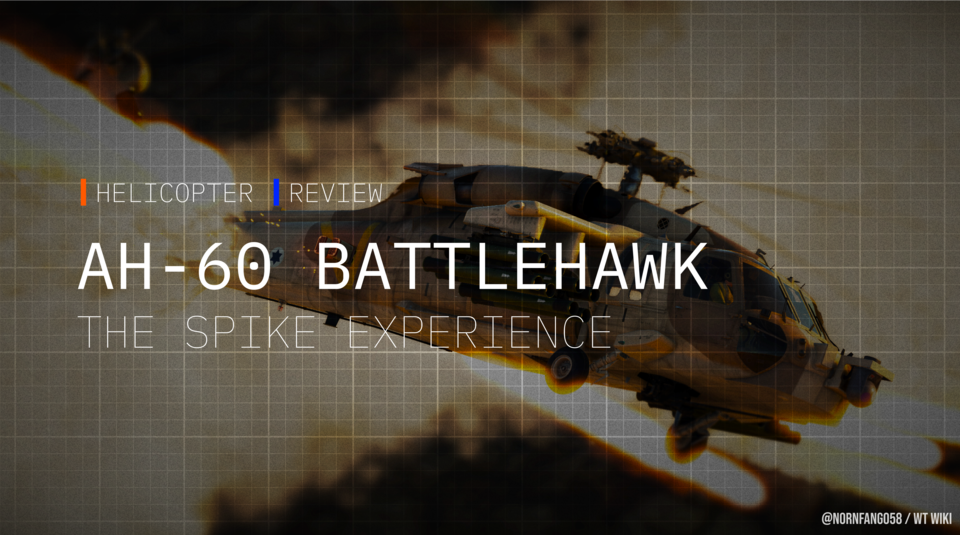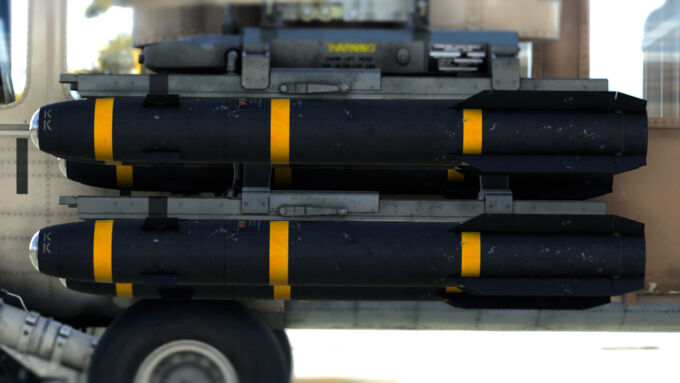The AH-60 Battlehawk is an Israeli development of the famed Sikorsky UH-60 Black Hawk utility helicopter, adapted for combat operations. With an exceptional air-to-ground armament in the form of 16 fire-and-forget SPIKE-ER missiles, the Battlehawk excels in ground engagements where it can devastate targets and overwhelm SPAAs with its SPIKEs while having the ability to dip behind cover to avoid any return fire.
| Pros | Cons |
|---|---|
| SPIKE-ER missiles are fire-and-forget capable | Less agile than its contemporaries |
| 20 mm underslung autocannon is accurate and effective against air targets | Very little armor protection for the pilot and gunner |
| 120 countermeasures, MAWS and IRCM | SPIKE-ERs can be inconsistent |
| Excellent targeting optics and thermal view | Autocannon has limited vertical firing arcs |
Flight performance
The Battlehawk is powered by two General Electric T700-GE-701C turboshaft engines, with each engine outputting 160 kgf. In level flight, the Battlehawk is capable of reaching speeds of approximately 240 to 260 km/h, depending on its altitude, and can reasonably keep up with most of its peers.
In terms of actual maneuverability, the Battlehawk handles quite sluggishly due to its heavy weight and large size. The Battlehawk will be easily outmaneuvered by other dedicated attack helicopters (Kamov Ka-50/52, Apache, Eurocopter, etc.)
Warning: Be careful when executing maneuvers close to the ground. A tree or the ground can easily clip and break the rotors or the tail.
Survivability
The Battlehawk has minimal armor, and the only physical protection for the two crew members are their armored seats, which are made out of kevlar boron carbide. Its main protection lies in its advanced survivability systems, which allow the Battlehawk to react proactively to potential threats.
Countermeasures + MAWS
The Battlehawk is equipped with 120 flare/chaff countermeasures, with two pods on each side of the helicopter near the tail. Flare countermeasures will fool IR missiles, while chaff distracts radar (SARH/ARH) missiles. Note that these countermeasures will not work against manually guided (SACLOS) missiles from ground-based SPAA.
Additionally, the Battlehawk also is equipped with a Missile Approach Warning System (MAWS) which displays an alert when an incoming missile is detected. MAWS will also automatically deploy the appropriate type of countermeasure.
RWR
To detect radar emissions, the Battlehawk is equipped with the AN/APR-39 Radar Warning Receiver (RWR). The AN/APR-39 detects all emissions in the E-M radar bands, and it provides track and launch warnings.
Paying attention to the RWR is crucial for survival in ground battles with other players, as many SPAA systems have radar-guided missiles. To evade these radar guided missiles, the pilot must fly perpendicular to the radar source at a 90° angle and deploy chaff countermeasures. This process is known as notching.
An alternative way to dodge radar missiles is by flying low to the ground to multipath the missile and confuse it with ground clutter. Using terrain or other objects to physically block a missile is also an effective tactic.
LWR
The AN/AVR-2 Laser Warning Receiver (LWR) can detect laser emissions that are targeted at the Battlehawk, provide a warning for the pilot, and indicate the direction of the laser emission source.
Common reasons for an LWR warning
- Enemy ground vehicles ranging the Battlehawk with their laser rangefinder
- Enemy helicopters locking onto the Battlehawk with laser lock, usually indicates that they have fired and are guiding an ATGM towards the helicopter
- Enemy aircraft locking onto the Battlehawk with a targeting pod (watch out for GBUs or AGMs)
IRCM
The Battlehawk’s Infrared Countermeasure (IRCM) module is located at the top of the helicopter behind the main rotor assembly. The IRCM module protects the Battlehawk from IR-guided missiles and fools them by projecting an infrared source with a higher intensity than the IR signature from the target.
Warning: The IRCM on the Battlehawk will stop some, but not all IR missiles.
Armaments for air targets
The Battlehawk is primarily armed for engaging ground targets, but it also features a 20 mm GIAT M.621 autocannon, which is highly effective at taking down air targets within 1.5 km. For longer-range targets, the Battlehawk can also use the AIM-92 ATAS missile, which is effective until 3 to 4 km.
20 mm GIAT M.621
The GIAT M.621 is the Battlehawk’s 20 mm autocannon, mounted on a turreted mount on the belly of the helicopter. It contains 430 rounds of ammunition.
With a high rate of fire and great accuracy, the GIAT is able to effectively destroy all types of aircraft. However, the GIAT does not get access to APDS and APFSDS ammunition for penetrating armor and can only penetrate up to 40 mm of armor with the AP-I/API-T rounds.
Ammunition belts
- Default: P · HEF-I · HEF-I ·API-T
- Universal: HEF-I · API-T
- Air Targets: HEF-I · HEF-I · HEF-I · API-T
- Armored Targets: API-T · AP-I · AP-I
- Stealth: HEF-I · HEF-I · HEF-I · AP-I
Note the GIAT has a limited vertical firing arc since it is mounted right below the helicopter. Due to this, the Battlehawk is unable to fire at targets that are above with the cannon. Pitching the Battlehawk upwards in order to hit targets may be necessary.
AIM-92 / ATAS
The AIM-92 (ATAS) is a helicopter mounted version of the FIM-92 Stinger missile. The Battlehawk can carry up to 2x AIM-92 missiles on each of its 4 pylons, for a grand total of 8x AIM-92 missiles.
The maneuverability of the AIM-92 is rather lackluster, with the missile only being able to pull up to 13 Gs and also having relatively mediocre target tracking. Luckily, the AIM-92 has an uncaged seeker allowing pilots to lead the missile to compensate for distance and/or the trajectory of the target.
However, the AIM-92 does have a dual-IRCCM system to enhance the missile’s resistance against flares and other heat decoys, and the AIM-92 can be quite hard to flare from a side or rear aspect.
Armaments for ground targets
The Battlehawk boasts an impressive arsenal of weaponry, featuring 70 mm unguided rockets for close-range combat and SPIKE-ER along with AGM-114K Hellfire II ATGMs for striking long-range targets up to 8 km away.
SPIKE-ER
The SPIKE-ER is a fire-and-forget IR-guided ATGM and serves as the signature weapon of the Battlehawk. Although it falls short in areas like damage and speed, the SPIKE-ER compensates with its great versatility and fire-and-forget capabilities. The Battlehawk can carry up to 16 of these missiles on 4 pylons, with 4 SPIKE-ERs on each pylon mount.
SPIKE-ERs are able to destroy all ground targets with its tandem HEAT warhead that can penetrate up to 1,000 mm of armor, but it performs the best against lightly armored vehicles and other helicopters.
Tip: Never rely on a single SPIKE to destroy an MBT. Always fire 2-3 missiles to ensure that the target is destroyed; if the first missile doesn’t destroy the tank, the second or third missile will.
The SPIKE-ER also can be quite inconsistent against MBTs, and it lacks the precision of a manually guided missile to target specific weakspots. The SPIKE-ER also travels at an abysmal speed of 180 m/s, so fired SPIKEs will take a while to reach a target. For comparison, the American Hellfire II travels at 475 m/s and the Russian Vikhr goes even faster, at 600 m/s. However, the SPIKE-ER’s slow speed is also a blessing in disguise: it allows the SPIKE-ER to make course corrections in time to hit maneuvering aircraft.
AGM-114K Hellfire II
The AGM-114K Hellfire II is an American laser-guided ATGM and the primary air-to-ground weapon of most modern American helicopters. Like the SPIKE-ER, the Hellfire II has a maximum range of 8 km and up to 16 missiles can be carried.
Unlike the SPIKE-ER, the Hellfire II is not fire-and-forget and requires continuous laser guidance. However, it has superior flight speed, greater damage, and better overall consistency.
In terms of damage, the Hellfire II can penetrate up to 1,200 mm of armor and has a 9.43 kg explosive warhead. It will obliterate any light tank or SPAA that it hits and can destroy MBTs quite easily.
The main disadvantage with the Hellfire II is that it requires constant laser guidance from the Battlehawk, so the pilot must typically maintain a line-of-sight with the target, which can expose the Battlehawk to enemy SPAA or other threats. Additionally, it cannot be used at extremely close distances (sub 1.5 km) since the missile attempts to loft before hitting a target, which will result in the Hellfire overshooting/flying over the intended target.
GATR
The Guided Advanced Tactical Rocket (GATR) is a laser guided missile and a conversion of the unguided Hydra-70 M247 rocket. It performs slightly better than its American counterpart, the APKWS II (M282). Up to 28 GATR rockets can be taken.
Note: It is strongly recommended to instead take the SPIKE-ER instead of the GATR.
The GATR is able to penetrate up to 41 mm of armor and has 568 grams of explosive filler. This is enough penetration to destroy lightly armored or open-top vehicles, but the GATR has inadequate damage to be able to critically damage or destroy all MBTs.
Hydra-70 M247
The Hydra-70 M247 is the ubiquitous unguided rocket found on many American helicopters and strike aircraft. The Hydra can penetrate up to 290 mm of armor with its HEAT warhead and is highly effective against lightly armored targets. It also has enough punch to critically damage and destroy MBTs. The Battlehawk is capable of carrying up to 76 Hydra rockets on all 4 pylons, with 19 rockets per pod.
Recommended loadout
- Countermeasures: 80 flares/40 chaff
- Secondary weapons: 16x SPIKE-ER, or 8x SPIKE-ER and 8x AGM-114K Hellfire II
- 20 mm gun belt: Universal
- Gun targeting distance: 600 m
- Fuel amount: Minimum (36 minutes)
Usage in battles
Even with the presence of SPAA and hostile aircraft in ground battles, the Battlehawk is able to wreak havoc on ground targets, and when flown skillfully, the Battlehawk has the potential to completely change the outcome of a match.
Ground Realistic Battles (GRB)
The Battlehawk shines in GRB, where it is able to wipe out ground targets while sitting behind friendly lines. Avoid getting close to the battle or “rocket rushing” with the Hydras, as the unarmored Battlehawk will be quickly shredded apart by vengeful enemies in a hail of machine gun fire.
In most matches, the Battlehawk’s playstyle is rather simple. Take off, find a suitable spot away from the battle, and then launch all of your SPIKE-ERs at enemy targets. If the Hellfire IIs are taken, use them primarily against MBTs. Make sure to stay on the lookout for enemy SPAA units and aircraft. A good thing to keep in mind is that both the SPIKE-ER and Hellfire II missiles have a max firing range of 8 km.
Tip: After taking off, reposition away from the helipad. Smart enemies in aircraft will commonly look for vulnerable helicopters hovering around the pad, too focused on missiling an enemy to notice the missile coming their way — don’t play into your enemy’s hands!
When dealing with SPAA, keep in mind that some SPAA are able to intercept fired munitions, with the most notable one being the Pantsir. To counter this, simply fire multiple SPIKE-ERs to overwhelm the target.
If an enemy aircraft attempts to attack the Battlehawk, pay attention to the MAWS and/or the RWR for signs of incoming missiles. Most enemies will attempt to shoot down the Battlehawk with their cannon within 1-1.5 km. Laser lock the aircraft in targeting view and then use the 20 mm GIAT under the fuselage to shred the incoming aircraft apart. Feel free to start maneuvering to avoid getting hit while firing the GIAT, since the Battlehawk’s ballistic computer will do all the aiming when the laser is locked on the target.
Helicopter PvE
In the Helicopter PvE gamemode, the Battlehawk is very well suited taking out waves of enemies. The best loadout for this gamemode is a full rack of 16x SPIKE-ER missiles. If needed, the Hydra rocket pods can also be taken to deal with close range targets.
The Battlehawk is arguably one of the best helicopters for Heli PvE, and it can single-handedly wipe out a wave of enemies or a convoy with its SPIKE-ERs very quickly. However, don’t get too close to enemies, since the Battlehawk is very vulnerable to machine gun and autocannon fire due to the lack of armor protection for the crew.
Conclusion
Overall, the Battlehawk excels at sitting behind friendly lines and utilizing its SPIKE-ER and Hellfire II missiles to demolish enemy ground units with relative impunity. Its lacking agility compared to its peers is something to always keep in mind, but the versatility the fire-and-forget missiles offer the Battlehawk is unparalleled and is its greatest strength.











